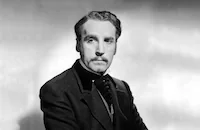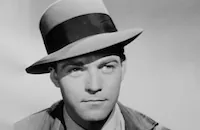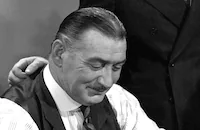The Firefly

Brief Synopsis
Cast & Crew
Robert Z. Leonard
Jeanette Macdonald
Allan Jones
Warren William
Billy Gilbert
Henry Daniell
Film Details
Technical Specs

Synopsis
In 1808, King Ferdinand VII is summoned by Napoleon, who secretly wants the king to abdicate. At a Madrid cafe, the popular singer Nina Maria, known as "The Firefly" sings and flirts with a member of the audience, Don Diego, because she would like to divert the attention of a jealous French officer named Etienne, while she meets secretly with the Marquis de Melito. While Etienne challenges Diego to a duel, Nina meets the marquis, who is a confidant of the king, and is assigned a spy mission to Bayonne to uncover Napoleon's plans for Spain. The next day, while Nina travels to Bayonne, Diego meets her coach and promises to ride with it to protect her from bandits. He also tells her that he has fallen in love with her. Though Diego's pursuit prevents Nina from speaking with her contact, she soon begins to realize that she is in love with Diego. In Bayonne, Nina meets Major de Rouchemont during a performance, when she playfully steals his hat. After going backstage to retrieve it, the major, who has just been made an aide to Napoleon, invites Nina to his chateau. There Nina discovers that the major is going to see Ferdinand and, searching through papers when the major leaves the room, she discovers a letter demanding that the king either abdicate or be arrested. Realizing that she must send the information to the marquis, she tries using carrier pigeons, but soon realizes that the birds she bought have been switched. After the pigeon salesman is arrested, Nina becomes suspicious of Diego and goes to his room and begs him to take a message for her. Members of the French secret service then break into the room and take the message. The contents of the message are innocuous, but Nina now knows that Diego is a French spy. He later confesses that his duty forced him to betray his love for her, but she will not listen. Soon Ferdinand is forced to abdicate and Napoleon's brother Joseph is crowned King of Spain. On the advice of the marquis, "The Firefly" disappears and Nina works in secret while the people gather strength to overthrow the French. Five years later, continuous war has ravaged Spain, but when the English come to her aide, the situation begins to change. Now, dressed as a common gypsy, Nina goes into a French camp, where she again meets the Marquis de Melito. Though he is surprised that she appears to be a camp follower, he offers to make Nina his mistress. When he later finds a map of French military positions in her possession, however, he summons his aide, Captain Andre François, who is the man Nina she knew as Diego. After Diego tells the major Nina's story, she is sentenced to death. Diego changes the information on her papers and sends it by carrier pigeon back to the Spanish forces at Vitorio, then goes to Nina to again profess his love. Just then a large battle begins at Vitorio and Nina reveals that her documents had merely been a ploy to force the French to change their strategy. After the French are defeated, the marquis finds Nina and tells her that she is now free. She then goes looking for Andre, whom she finds lying wounded on the battlefield. He recovers, and with their war now over, they then ride off together through the mountains.

Director

Robert Z. Leonard
Cast

Jeanette Macdonald

Allan Jones

Warren William

Billy Gilbert

Henry Daniell

Douglas Dumbrille
Leonard Penn
Tom Rutherford
Belle Mitchell

George Zucco
Corbett Morris
Matthew Boulton

Alan Curtis
Ralph Byrd

Edward Keene
Ramsay Hill
Lew Harvey
Peter Du Rey
Anthony Pawley

Ien Wulf
Manuel Alvarez Maciste
Zeni Vatori

Frank Puglia
Robert Spindola
John Picorri
James B. Carson
Milton Watson
Donald Reed
William Crowell
Drew Demarest
Lester Dorr
John Merton
Maurice Cass
Mabel Colcord
Theodor Von Eltz
Pedro De Cordoba
Monya Andre
Frank Campeau
Stanley Price
Guy D'ennery
Robert Wilber
Raphael Bennett
Jacques Lory
Inez Palange
Sam Appel
Maurice Black
Rolfe Sedan
Sidney Bracy
Roy Harris
Eugene Borden
Eddie Phillips
Jean Perry
Bentley Hewlett
Paul Sutton
Karl Hackett
Charles Townsend
Fred Mackaye
Roger Drake
Hooper Atchley
Boyd Gilbert
Russ Powell
Lane Chandler
Agostino Borgato
Joe North
Colin Kenny

Brandon Hurst
Pat Somerset
Victor Adams
Harry Worth
Gabriel Munoz
Carlos Ruffino
Pilar Arcos
St. Luke's Choristers
St. Brendan's Boys Choir
Our Lady Of The Angels Choir
Crew
Adrian
Chet Forrest
Rudolf Friml
Cedric Gibbons
Frances Goodrich
Paul Groesse
Albert Hackett
Otto A. Harbach
Gus Kahn
Robert J. Kern
Robert Z. Leonard
Oliver T. Marsh
Mike Mclaughlin
Alice Duer Miller
Ogden Nash
Joseph Newman
Leonid Raab
Albertina Rasch
Enrico Ricardi
George Richelavie
Carlos Ruffino
Douglas Shearer
Elmer Sheeley
Herbert Stothart
Hunt Stromberg
Slavko Vorkapich
Claudine West
Edwin B. Willis
Bob Wright

Videos
Movie Clip



Trailer
Film Details
Technical Specs

Articles
The Firefly
The Firefly is based on a 1912 operetta by Rudolf Friml and Otto Harbach, but the songs are all that remain from that source, which was about an Italian waif in early 20th century U.S. who becomes an opera singer. The husband and wife screenwriting team of Frances Goodrich and Albert Hackett, along with humorist Ogden Nash, created an entirely new story about a cabaret dancer in Napoleonic-era Spain who is also a spy trying to discover Napoleon's plans for invading Spain. According to MacDonald biographer Edward Baron Turk, "it was an unprecedented attempt to break new ground by merging two ordinarily separate Hollywood film genres: the historical war epic and the musical." In the context of the times, the film's subtext was also daring, according to Turk. Civil war was then raging in Spain, and "all three screenwriters were sympathetic to the ongoing Republican struggle against Fascism.... They conceived of The Firefly as a protest against dictatorial oppression." Maybe so, but MGM was still MGM, and the film was more about entertainment than politics. MacDonald's dancing spy falls in love with a Spanish nobleman who is actually a spy for the French, with Jones making a much more dashing spy than the stout and stolid Eddy would have been.
Although MacDonald had been a dancer on Broadway, she had not done much dancing in films. For two months before production started on The Firefly, she studied Spanish dance daily. And once the film was in production, she trained for 90 minutes each day with choreographer Albertina Rasch. MGM gave The Firefly a lavish budget, and its usual superb production values. Costume designer Adrian designed an extravagant wardrobe of Empire-style costumes, including one outfit for MacDonald which used over 150 yards of lace and thousands of spangles which took two weeks to sew on. Even the makeup was spectacular. Studio publicists announced that makeup director Jack Dawn had to get government permission to mix gold dust into MacDonald's face powder. The Firefly was shot on 30 major sets, and used some 500 extras.
MacDonald had solo above-the-title billing on The Firefly for the first time in her career, but Jones recalled that her behavior toward him was generous. On the first day they worked together, she told cinematographer Oliver T. Marsh, "Allan and I are co-stars. He is to get equal treatment. Everything you do for me, do for him. He is to get the same number of close-ups." She told Jones that changing partners had energized her performance. Jones also got another gift: a new song, which became the hit of the film and Jones' lifelong theme song. "Donkey Serenade" was adapted by musical director Herbert Stothart, Bob Wright, and Chet Forrest, from a piano piece of Friml's, "Chanson." Friml hated it, and sued MGM for copyright infringement. The suit was settled out of court. But the song, and the film, did prove to be somewhat unlucky for Jones. While filming "Donkey Serenade" on location, Jones' horse was pinned between MacDonald's carriage and a rock, and Jones suffered a foot injury.
The injury to Jones' career was even worse. The Firefly earned excellent reviews, but it was not as successful as the MacDonald-Eddy films, and Mayer blamed Jones. Although The Firefly was the 15th-highest grossing film of the year, its profit was barely one-tenth of its huge production budget. MacDonald was urging Mayer to consider Jones for her co-star in The Girl of the Golden West (1938), but Nelson Eddy, who had Mayer's ear and was feeling threatened by Jones, protested. Mayer didn't like Jones' independent ways, and sided with Eddy. And Jones found himself sitting out the rest of his MGM contract. Although he worked sporadically at other studios, Jones' film career never really recovered.
Director: Robert Z. Leonard
Producer: Hunt Stromberg, Robert Z. Leonard
Screenplay: Frances Goodrich, Albert Hackett, Ogden Nash, from the musical book by Otto A. Harbach
Cinematography: Oliver T. Marsh
Editor: Robert J. Kern
Costume Design: Adrian
Art Direction: Cedric Gibbons
Music: Rudolf Friml
Principal Cast: Jeanette MacDonald (Nina Maria Azara), Allan Jones (Don Diego Manrique de Lara), Warren William (Col. DeRougemont), Douglas Dumbrille (Marquis DeMelito), Leonard Penn (Etienne), Billy Gilbert (Innkeeper), Belle Mitchell (Lola).
BW-130m. Closed captioning.
by Margarita Landazuri

The Firefly
Quotes
You have one bad habit.- Don Diego
Oh, yes? What?- Nina Maria Azara
You're always saying good-bye.- Don Diego
Very well then, I won't say good-bye. I'll just go!- Nina Maria Azara
Trivia
The song "Donkey Serenade" was not in the original stage production. It was written for the film, but the music was adapted from the song "Chansonette", from the stage version of "The Firefly".
Notes
The preview running time for the film was 140 minutes. According to a Hollywood Reporter news item in August 1936, Ogden Nash's preparation of a treatment of the original Otto A. Harbuach, Rudolf Friml operetta was his first assignment in Hollywood. A May 25, 1937 Hollywood Reporter news item noted that music director Herbert Stothart, accompanied by Leon Raab (music arranger) and Mike McLaughlin (sound recorder), had just returned from Mexico where they had recorded music for the film. The song "The Donkey Serenade" became one of the most popular songs of the year after its appearance in the film. The song was re-written by composers Rudolf Friml, Bob Wright and Chet Forrest from an earlier song Friml had composed entitled "Chanson." A Hollywood Reporter news item on June 8, 1937 noted that because of the cost, M-G-M was going to take a $300,000 loss on the picture. Jeanette MacDonald married Gene Raymond on June 16, 1937, just after her scenes in the picture were completed. Portions of the film were shot on location in Lone Pine, CA.















